Related Research Articles
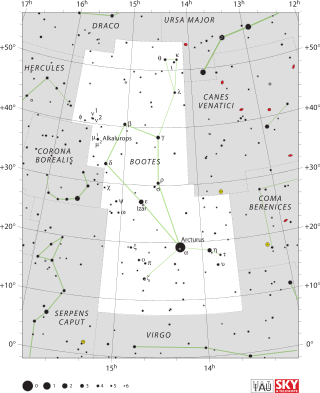
Arcturus is the brightest star in the northern constellation of Boötes. With an apparent visual magnitude of −0.05, it is the fourth-brightest star in the night sky, and the brightest in the northern celestial hemisphere. The name Arcturus originated from ancient Greece; it was then cataloged as α Boötis by Johann Bayer in 1603, which is Latinized to Alpha Boötis. Arcturus forms one corner of the Spring Triangle asterism.
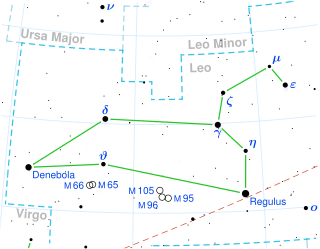
Regulus is the brightest object in the constellation Leo and one of the brightest stars in the night sky. It has the Bayer designation designated α Leonis, which is Latinized to Alpha Leonis, and abbreviated Alpha Leo or α Leo. Regulus appears singular, but is actually a quadruple star system composed of four stars that are organized into two pairs. The spectroscopic binary Regulus A consists of a blue-white main-sequence star and its companion, which has not yet been directly observed, but is probably a white dwarf. The system lies approximately 79 light years from the Sun.

The Cat's Eye Nebula is a planetary nebula in the northern constellation of Draco, discovered by William Herschel on February 15, 1786. It was the first planetary nebula whose spectrum was investigated by the English amateur astronomer William Huggins, demonstrating that planetary nebulae were gaseous and not stellar in nature. Structurally, the object has had high-resolution images by the Hubble Space Telescope revealing knots, jets, bubbles and complex arcs, being illuminated by the central hot planetary nebula nucleus (PNN). It is a well-studied object that has been observed from radio to X-ray wavelengths.

Beta Andromedae, Latinized from β Andromedae, and officially named Mirach, is a prominent star in the northern constellation of Andromeda. It is northeast of the Great Square of Pegasus and is potentially visible to all observers north of latitude 54° S. It is commonly used by stargazers to find the Andromeda Galaxy. The galaxy NGC 404, also known as Mirach's Ghost, is seven arcminutes away from Mirach.
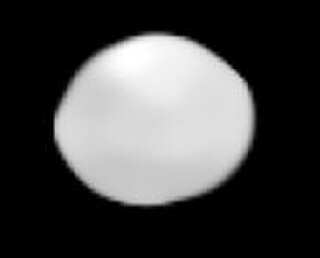
Euphrosyne is a very young asteroid. It is the one of the largest asteroids. It was discovered by James Ferguson on September 1, 1854, the first asteroid found from North America. It is named after Euphrosyne, one of the Charites in Greek mythology. In 2019 a small companion was discovered. It is the third-roundest known asteroid ; this is thought to be due to having re-accreted after being disrupted by a collision, and it is not close to hydrostatic equilibrium.

Camilla is one of the largest asteroids from the outermost edge of the asteroid belt, approximately 250 kilometers in diameter. It is a member of the Sylvia family and located within the Cybele group. It was discovered on 17 November 1868, by English astronomer Norman Pogson at Madras Observatory, India, and named after Camilla, Queen of the Volsci in Roman mythology. The X-type asteroid is a rare trinary asteroid with two minor-planet moons discovered in 2001 and 2016, respectively. It is elongated in shape and has a short rotation period of 4.8 hours.

Zeta Reticuli, Latinized from ζ Reticuli, is a wide binary star system in the southern constellation of Reticulum. From the southern hemisphere the pair can be seen with the naked eye as a double star in very dark skies. Based upon parallax measurements, this system is located at a distance of about 39.3 light-years from Earth. Both stars are solar analogs that have characteristics similar to those of the Sun. They belong to the Zeta Herculis Moving Group of stars that share a common origin.
HD 37124 is a star in the equatorial constellation of Taurus, positioned about a half degree to the SSW of the bright star Zeta Tauri. The apparent visual magnitude of this star is 7.68, which is too dim to be visible to the naked eye. It is located at a distance of 103 light years from the Sun based on parallax, but is drifting closer with a radial velocity of −23 km/s. Three extrasolar planets have been found to orbit the star.
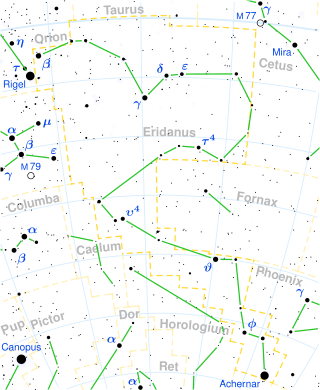
HD 10647 is a 6th-magnitude yellow-white dwarf star, 57 light-years away in the constellation of Eridanus. The star is visible to the unaided eye under very dark skies. It is slightly hotter and more luminous than the Sun, and at 1.75 billion years old, it is also younger. An extrasolar planet was discovered orbiting this star in 2003.

18 Scorpii is a solitary star located at a distance of some 46.1 light-years from the Sun at the northern edge of the Scorpius constellation. It has an apparent visual magnitude of 5.5, which is bright enough to be seen with the naked eye outside of urban areas. The star is drifting further away with a radial velocity of +11.6.

The Milky Way is the galaxy that includes the Solar System, with the name describing the galaxy's appearance from Earth: a hazy band of light seen in the night sky formed from stars that cannot be individually distinguished by the naked eye. The term Milky Way is a translation of the Latin via lactea, from the Greek γαλακτικὸς κύκλος, meaning "milky circle". From Earth, the Milky Way appears as a band because its disk-shaped structure is viewed from within. Galileo Galilei first resolved the band of light into individual stars with his telescope in 1610. Until the early 1920s, most astronomers thought that the Milky Way contained all the stars in the Universe. Following the 1920 Great Debate between the astronomers Harlow Shapley and Heber Doust Curtis, observations by Edwin Hubble showed that the Milky Way is just one of many galaxies.

HD 219134 is a main-sequence star in the constellation of Cassiopeia. It is smaller and less luminous than the Sun, with a spectral class of K3V, which makes it an orange-hued star. HD 219134 is relatively close to our system, with an estimated distance of 21.34 light years. This star is close to the limit of apparent magnitude that can still be seen by the unaided eye. The limit is considered to be magnitude 6 for most observers. This star has a magnitude 9.4 optical companion at an angular separation of 106.6 arcseconds.
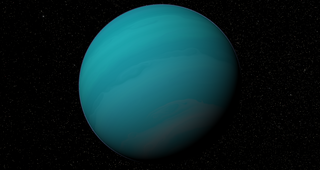
Gliese 876 b is an exoplanet orbiting the red dwarf Gliese 876. It completes one orbit in approximately 61 days. Discovered in June 1998, Gliese 876 b was the first planet to be discovered orbiting a red dwarf.

NGC 5170 is a large, nearby, edge-on spiral galaxy in the equatorial constellation of Virgo. It was discovered on February 7, 1785 by William Herschel. This galaxy is located at a distance of 83.5 million light years and is receding at a heliocentric radial velocity of 1,502 km/s. It is a member of the Virgo II Groups, a series of galaxies and galaxy clusters strung out from the southern edge of the Virgo Supercluster.

Kappa Coronae Borealis, Latinized from κ Coronae Borealis, is the star approximately 98 light years away in the constellation of Corona Borealis. The apparent magnitude is +4.82 and the absolute magnitude is +2.35. It is an orange K-type subgiant star of spectral type K1IV, meaning it has almost completely exhausted its hydrogen supply in its core. It is 1.32 times as massive as the Sun yet has brightened to 11.6 times its luminosity. Around 2.5 billion years old, it was formerly an A-type main sequence star.

The Blue Lias is a geological formation in southern, eastern and western England and parts of South Wales, part of the Lias Group. The Blue Lias consists of a sequence of limestone and shale layers, laid down in latest Triassic and early Jurassic times, between 195 and 200 million years ago. The Blue Lias is famous for its fossils, especially ammonites.
1 Scorpii, or b Scorpii, is a single star in the southern zodiac constellation of Scorpius. It has an apparent magnitude of 4.63, which is bright enough to be faintly visible to the naked eye on a dark night. The star shows an annual parallax shift of 6.59 mas from Earth's orbit, which equates to a distance of roughly 490 light years. It is a probable member of the Sco OB2 moving group.

NGC 7090 is a spiral galaxy in the southern constellation of Indus located about 31 million light-years away. English astronomer John Herschel first observed this galaxy on 4 October 1834.
GJ 625 is a small red dwarf star with an exoplanetary companion in the northern constellation of Draco. The system is located at a distance of 21.1 light-years from the Sun based on parallax, but is drifting closer with a radial velocity of −13 km/s. It is too faint to be visible to the naked eye, having an apparent visual magnitude of 10.13 and an absolute magnitude of 11.06.

NGC 127 is a lenticular galaxy that was discovered on November 4, 1850, by Bindon Stoney, the same day he discovered NGC 126 and NGC 130. NGC 127 is a gas-rich, star-forming galaxy showing emission lines. It is an interacting companion to the peculiar, edge-on galaxy NGC 128, and the pair are connected by a bridge of material. The south-east part of NGC 127 is asymmetrical in the direction of NGC 128. It may have recently passed the more massive NGC 128, from which an infall of gas is flowing onto NGC 127.
References
- ↑ Carney, J. N., et al., 2008 40Ar–39Ar isotope constraints on the age of deformation in Charnwood Forest, UK, Geol. Mag. 145 (5), 2008, pp. 702–713
- ↑ British Geological Survey 1996 Tectonic map of Britain, Ireland and adjacent areas Pharaoh, T.C. et al 1:1,500,000 (Keyworth, Nottingham: BGS)
